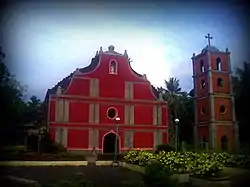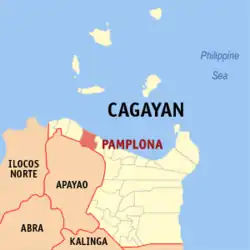Pamplona, Cagayan
Pamplona, officially the Municipality of Pamplona (Ibanag: Ili nat Pamplona; Ilocano: Ili ti Pamplona; Tagalog: Bayan ng Pamplona), is a 4th class municipality in the province of Cagayan, Philippines. According to the 2020 census, it has a population of 24,781 people.[3]
Pamplona | |
|---|---|
| Municipality of Pamplona | |
 St. Peter the Martyr Parish Church of Pamplona, Cagayan | |
 Flag  Seal | |
 Map of Cagayan with Pamplona highlighted | |
OpenStreetMap | |
.svg.png.webp) Pamplona Location within the Philippines | |
| Coordinates: 18°27′58″N 121°20′33″E | |
| Country | Philippines |
| Region | Cagayan Valley |
| Province | Cagayan |
| District | 2nd district |
| Founded | 1842 |
| Named for | Pamplona, Spain |
| Barangays | 18 (see Barangays) |
| Government | |
| • Type | Sangguniang Bayan |
| • Mayor | Digna G. Puzon-Antonio |
| • Vice Mayor | Azarelle M. Bilas |
| • Representative | Baby Aline V. Alfonso |
| • Electorate | 16,702 voters (2022) |
| Area | |
| • Total | 173.30 km2 (66.91 sq mi) |
| Elevation | 50 m (160 ft) |
| Highest elevation | 783 m (2,569 ft) |
| Lowest elevation | 0 m (0 ft) |
| Population (2020 census)[3] | |
| • Total | 24,781 |
| • Density | 140/km2 (370/sq mi) |
| • Households | 5,850 |
| Economy | |
| • Income class | 4th municipal income class |
| • Poverty incidence | 16.40 |
| • Revenue | ₱ 123.3 million (2020) |
| • Assets | ₱ 312.4 million (2020) |
| • Expenditure | ₱ 93.58 million (2020) |
| • Liabilities | ₱ 75.32 million (2020) |
| Service provider | |
| • Electricity | Cagayan 2 Electric Cooperative (CAGELCO 2) |
| Time zone | UTC+8 (PST) |
| ZIP code | 3522 |
| PSGC | |
| IDD : area code | +63 (0)78 |
| Native languages | Ilocano Ibanag Atta Tagalog |
| Website | www |
Pamplona is 138 kilometres (86 mi) from Tuguegarao and 619 kilometres (385 mi) from Manila.
History
Pamplona is the result of the fusion of two villages during the Spanish era; Abulacan (now barrio San Juan) and Masi. Abulacan was founded by the ecclesiastical authorities on April 30, 1757, with San Juan Nepomuceno as the patron saint. Sometime in 1842, Vicar Pedro Montenegro, O.P. convinced the people to unite the two towns. The vicar named it "Pamplona" in memory of his hometown Pamplona in Spain.
After the fusion, an agreement was made that there would be two patron saints of Pamplona: San Juan Nepomuceno and San Pedro de Martir. This is the reason why the town fiesta is celebrated for two days and the images of the two patron saints are carried during religious processions. The town fiesta is celebrated every April 29.
In 1919, some of the prominent people of Pamplona recommended the transfer of the same to Bidduang, a barrio of Pamplona. The transfer was made on November 16, 1919, during the administration of municipal president Esteban Meneses by order of General Wood. In 1928, on the sixth year of the administration of municipal president Paulino Ifurung, one of his last acts was the transfer of the municipal government back to its old site, Pamplona, by then called "Albano."
Most interesting spot is the mouth of the Pamplona River. It saw history in the making for it was the starting point of Salcedo and his conquistadores when they explored Cagayan in 1572. Because of the river's strong current and unpredictable floods, Mayor Nicolas B. Aquino built in 1955 a concrete levee along Barangay Masi. He also built an irrigation system. It was the first of its kind in Cagayan.
The town is also noted for its Malagabavi Cave and waterfall. It is located at the foot of a mountain virtually shaped like a pig. Legend has it that this cave was used by a giant as an entrance to his abode. It is said that he was a normal being like a human until his transformation to a giant by a goddess who fell in love with him.
Geography
Barangays
Pamplona is politically subdivided into 18 barangays. Each barangay consists of puroks while some have sitios.
- Abbangkeruan
- Allasitan
- Bagu
- Balingit
- Bidduang
- Cabaggan
- Capalalian
- Casitan
- Centro
- Curva
- Gattu
- Masi (formerly Zimigui-Ziuanan[5])
- Nagattatan
- Nagtupacan
- San Juan
- Santa Cruz (Pimpila)
- Tabba
- Tupanna
Climate
| Climate data for Pamplona, Cagayan | |||||||||||||
|---|---|---|---|---|---|---|---|---|---|---|---|---|---|
| Month | Jan | Feb | Mar | Apr | May | Jun | Jul | Aug | Sep | Oct | Nov | Dec | Year |
| Average high °C (°F) | 25 (77) |
26 (79) |
29 (84) |
31 (88) |
31 (88) |
31 (88) |
30 (86) |
30 (86) |
30 (86) |
28 (82) |
27 (81) |
25 (77) |
29 (84) |
| Average low °C (°F) | 20 (68) |
20 (68) |
21 (70) |
23 (73) |
24 (75) |
25 (77) |
25 (77) |
25 (77) |
24 (75) |
23 (73) |
23 (73) |
21 (70) |
23 (73) |
| Average precipitation mm (inches) | 120 (4.7) |
77 (3.0) |
62 (2.4) |
40 (1.6) |
118 (4.6) |
138 (5.4) |
162 (6.4) |
173 (6.8) |
143 (5.6) |
198 (7.8) |
185 (7.3) |
248 (9.8) |
1,664 (65.4) |
| Average rainy days | 16.9 | 12.2 | 11.5 | 10.6 | 18.7 | 20.1 | 21.2 | 23.3 | 20.8 | 16.9 | 16.5 | 20.0 | 208.7 |
| Source: Meteoblue[6] | |||||||||||||
Demographics
| Year | Pop. | ±% p.a. |
|---|---|---|
| 1903 | 3,089 | — |
| 1918 | 3,672 | +1.16% |
| 1939 | 7,650 | +3.56% |
| 1948 | 8,029 | +0.54% |
| 1960 | 10,026 | +1.87% |
| 1970 | 13,568 | +3.07% |
| 1975 | 14,965 | +1.98% |
| 1980 | 17,603 | +3.30% |
| 1990 | 16,775 | −0.48% |
| 1995 | 18,107 | +1.44% |
| 2000 | 20,142 | +2.31% |
| 2007 | 21,889 | +1.15% |
| 2010 | 23,236 | +2.20% |
| 2015 | 23,596 | +0.29% |
| 2020 | 24,781 | +0.97% |
| Source: Philippine Statistics Authority[7][8][9][10] | ||
In the 2020 census, the population of Pamplona, Cagayan, was 24,781 people,[3] with a density of 140 inhabitants per square kilometre or 360 inhabitants per square mile.
Economy
Government
Local government
Pamplona, belonging to the second legislative district of the province of Cagayan, is governed by a mayor designated as its local chief executive and by a municipal council as its legislative body in accordance with the Local Government Code. The mayor, vice mayor, and the councilors are elected directly by the people through an election which is being held every three years.
Elected officials
| Position | Name |
|---|---|
| Congressman | Samantha Louise V. Alfonso |
| Mayor | Digna G. Puzon-Antonio |
| Vice-Mayor | Azarelle M. Bilas |
| Councilors | Ria Angela G. Sampaga |
| Marlon R. Yamongan | |
| John Fritz Herbert S. Roque | |
| Alicia L. Banham | |
| Laurence E. Daguna | |
| Leticia F. Echenique | |
| Felix M. Zimara | |
| Aristotle Y. Maquiraya | |
Education
The Schools Division of Cagayan governs the town's public education system.[19] The division office is a field office of the DepEd in Cagayan Valley region.[20] The office governs the public and private elementary and public and private high schools throughout the municipality.
References
- Municipality of Pamplona | (DILG)
- "2015 Census of Population, Report No. 3 – Population, Land Area, and Population Density" (PDF). Philippine Statistics Authority. Quezon City, Philippines. August 2016. ISSN 0117-1453. Archived (PDF) from the original on May 25, 2021. Retrieved July 16, 2021.
- Census of Population (2020). "Region II (Cagayan Valley)". Total Population by Province, City, Municipality and Barangay. Philippine Statistics Authority. Retrieved 8 July 2021.
- "PSA Releases the 2018 Municipal and City Level Poverty Estimates". Philippine Statistics Authority. 15 December 2021. Retrieved 22 January 2022.
- "An Act Changing the Name of Barrio Zimigui-ziuanan, Municipality of Pamplona, Province of Cagayan, to Masi". LawPH.com. Retrieved 2011-04-12.
- "Pamplona, Cagayan: Average Temperatures and Rainfall". Meteoblue. Retrieved 15 December 2018.
- Census of Population (2015). "Region II (Cagayan Valley)". Total Population by Province, City, Municipality and Barangay. Philippine Statistics Authority. Retrieved 20 June 2016.
- Census of Population and Housing (2010). "Region II (Cagayan Valley)". Total Population by Province, City, Municipality and Barangay. National Statistics Office. Retrieved 29 June 2016.
- Censuses of Population (1903–2007). "Region II (Cagayan Valley)". Table 1. Population Enumerated in Various Censuses by Province/Highly Urbanized City: 1903 to 2007. National Statistics Office.
- "Province of Cagayan". Municipality Population Data. Local Water Utilities Administration Research Division. Retrieved 17 December 2016.
- "Poverty incidence (PI):". Philippine Statistics Authority. Retrieved December 28, 2020.
- "Estimation of Local Poverty in the Philippines" (PDF). Philippine Statistics Authority. 29 November 2005.
- "2003 City and Municipal Level Poverty Estimates" (PDF). Philippine Statistics Authority. 23 March 2009.
- "City and Municipal Level Poverty Estimates; 2006 and 2009" (PDF). Philippine Statistics Authority. 3 August 2012.
- "2012 Municipal and City Level Poverty Estimates" (PDF). Philippine Statistics Authority. 31 May 2016.
- "Municipal and City Level Small Area Poverty Estimates; 2009, 2012 and 2015". Philippine Statistics Authority. 10 July 2019.
- "PSA Releases the 2018 Municipal and City Level Poverty Estimates". Philippine Statistics Authority. 15 December 2021. Retrieved 22 January 2022.
- "2019 National and Local Elections" (PDF). Commission on Elections. Retrieved March 10, 2022.
- "History of DepED SDO Cagayan". DepED SDO Cagayan | Official Website of DepED SDO Cagayan. Retrieved March 13, 2022.
- "DEPED REGIONAL OFFICE NO. 02". DepED RO2 | The official website of DepED Regional Office No. 02.